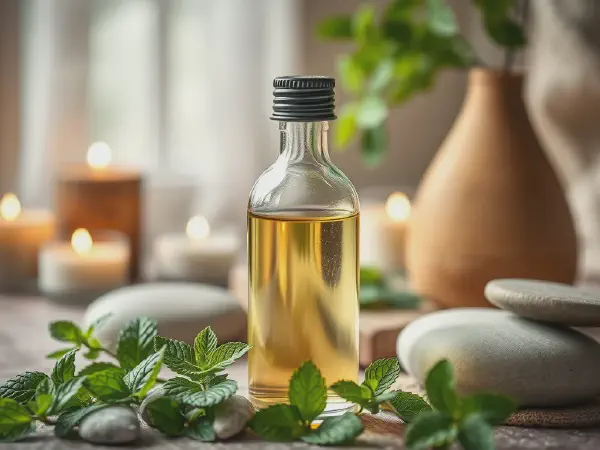Discover Peppermint Essential Oil Benefits & Creative Uses

The Versatile Peppermint Essential Oil: Benefits, Uses, and Precautions
Peppermint Essential Oil is derived from the leaves of the peppermint plant, scientifically known as Mentha × piperita. This popular oil is well-known for its invigorating and refreshing aroma, along with its various health benefits. It has been used for centuries in traditional medicine, culinary applications, and even in beauty products, making it a staple in many households. Its versatility and effectiveness are what make Peppermint Essential Oil a favorite among essential oil enthusiasts.
The extraction of Peppermint Essential Oil typically involves steam distillation of the fresh peppermint leaves. This process retains the plant's powerful properties, yielding an oil that is rich in menthol and other beneficial compounds. Some common uses of this essential oil include improving digestive health, relieving headaches, and providing respiratory support. In addition, many people appreciate its uplifting scent that can help enhance mood and promote relaxation.
Peppermint Essential Oil is also renowned for its wide array of creative uses beyond aromatherapy. It can be used in crafting homemade candles, refreshing home sprays, and even in culinary dishes. Additionally, peppermint oil can be incorporated into beauty products. Its cooling effect and pleasant scent make it a valuable ingredient for a variety of applications, from conditioners to foot baths. This article will delve deeper into the health benefits, creative uses, and safety precautions associated with Peppermint Essential Oil.
As with any essential oil, it’s essential to understand how to use Peppermint Essential Oil safely and effectively. This oil contains potent compounds that can be beneficial for health, but improper use can lead to adverse effects. It's important to dilute the oil when applying it to the skin and to be mindful of its concentration in various applications. In this comprehensive article, we will explore the myriad ways in which Peppermint Essential Oil can be utilized, its remarkable health benefits, and the safety precautions to take while using it.
Utilizing natural remedies can enhance well-being; exploring the therapeutic benefits of Essential oil blends is a great place to start.
From enhancing digestive health to boosting mental clarity, Peppermint Essential Oil holds a myriad of potential benefits. This article will explore these benefits in detail, along with creative uses that can enhance both wellness and home life. Whether you are a seasoned essential oil user or a novice, you'll find valuable insights into why Peppermint Essential Oil deserves a place in your home.
Health Benefits of Peppermint Essential Oil
One of the primary health benefits of Peppermint Essential Oil is its ability to improve digestive health. It can help relieve symptoms associated with indigestion, bloating, and gas. The menthol in peppermint oil aids in relaxing the digestive tract muscles, allowing for smoother digestion. Moreover, it is thought to stimulate bile flow, enhancing overall digestive processes and reducing discomfort after meals.
Natural headache relief is another prominent benefit of Peppermint Essential Oil. When inhaled or applied to the temples, its cooling sensation can alleviate tension headaches and migraines. The oil acts as a natural stimulant, improving blood circulation, and its antispasmodic properties contribute to reducing the severity of headaches, making it a popular choice for those seeking drug-free relief.
Peppermint Essential Oil is also known for providing respiratory support and relief. Inhaling the oil may help clear nasal passages, alleviate sinus congestion, and soothe coughs. Its anti-inflammatory properties can reduce swelling in the respiratory tract, making it easier to breathe. Many people utilize peppermint oil in steam inhalation to promote clear breathing, especially during cold and allergy seasons.
In addition to its physical health benefits, Peppermint Essential Oil can enhance mood and promote relaxation. Its invigorating scent can uplift spirits, increase focus, and help alleviate feelings of anxiety or stress. Diffusing peppermint oil or adding it to a bath can create a refreshing atmosphere, fostering feelings of tranquility and encouraging relaxation after a long day.
Finally, Peppermint Essential Oil can provide pain relief for sore muscles. Its cooling properties can soothe muscular discomfort and enhance circulation when applied topically. Many athletes and those engaged in physical activities incorporate peppermint oil into their post-workout routine to ease tension and promote faster recovery.
Creative Uses of Peppermint Essential Oil
One creative use of Peppermint Essential Oil is in DIY peppermint essential oil candles. By adding a few drops of the oil to candle wax before pouring it into molds, you can create delightful candles that fill your space with a minty aroma while providing the benefits of aromatherapy when lit.
Another fun application is creating refreshing peppermint sprays for your home. Simply combine water, a few drops of peppermint oil, and witch hazel in a spray bottle to create a natural air freshener. This spray not only freshens the air but can also repel pests, making your home a more pleasant space.
Incorporating peppermint oil into cooking is another fantastic way to enjoy its flavor and health benefits. A drop in desserts, mint teas, or savory dishes can elevate your culinary experience. However, be cautious with dosage, as peppermint oil is highly concentrated compared to fresh herbs.
Soothing foot baths with peppermint oil is also an excellent way to relax. Adding a few drops of peppermint oil to warm water can provide relief for tired feet, leaving them feeling refreshed and rejuvenated after a long day.
Lastly, customizing beauty products with peppermint oil can transform your skincare routine. Whether it’s adding it to moisturizers, shampoos, or lip balms, peppermint oil provides a refreshing sensation and can enhance your products with its invigorating scent.
Peppermint Essential Oil in Aromatherapy
Diffusing peppermint oil for relaxation is a widely practiced method in aromatherapy. Using an essential oil diffuser or a diffuser necklace, the fresh scent of peppermint can fill your space, promoting a calming atmosphere and enhancing overall well-being.
Combining peppermint with other essential oils can yield synergistic effects. Blending peppermint oil with lavender or eucalyptus can create a balance between invigorating stimulation and calming properties, making it ideal for meditation or relaxation sessions.
Inhalation therapy with peppermint offers numerous benefits, such as improving focus and clarity. Simply inhaling the scent can stimulate the mind and provide an instant energy boost, perfect for tackling demanding tasks or boosting creative thinking.
Creating personalized aromatherapy blends using peppermint oil can enhance your practice of self-care. Combining peppermint with oils like lemon, orange, or tea tree can create unique fragrances tailored to your preferences, allowing you to enjoy the therapeutic benefits specific to your needs.
Lastly, incorporating peppermint oil into meditation practices can elevate your experience. Its refreshing aroma can help awaken the senses, making it easier to focus and facilitate a more profound meditative state.
Safety and Precautions with Peppermint Essential Oil
When using Peppermint Essential Oil, proper dilution methods are essential, especially for skin application. It is recommended to dilute peppermint oil with a carrier oil, such as coconut or jojoba oil, to prevent irritation and ensure safe application on the skin.
Possible side effects and contraindications should be considered, as some individuals may experience allergic reactions to peppermint oil. Additionally, those with certain medical conditions or pregnant women should consult with a healthcare provider before using peppermint oil to avoid complications.
Guidelines for using peppermint with children should also be observed. It is recommended to avoid direct application to young children’s skin, as their skin is more sensitive. Always consult a pediatrician regarding appropriate usage for children.
Storage and shelf life of peppermint oil is another important consideration. To retain its potency, peppermint oil should be stored in a cool, dark place, ideally in a dark glass bottle, to protect it from sunlight and heat, which can degrade its quality over time.
Finally, understanding oil quality and purity is crucial. Always choose high-quality, pure peppermint essential oil from reputable brands to ensure that you are receiving the full benefits without contamination or synthetic additives.
Peppermint Essential Oil for Skin and Hair
Peppermint Essential Oil offers remarkable benefits for acne-prone skin attribute to its antibacterial properties. It can help reduce inflammation and redness, promoting clearer skin when applied in diluted form in skincare products.
In scalp treatments, peppermint oil stimulates blood flow, promoting hair growth and alleviating dandruff. Adding a few drops to shampoo or combining it with a carrier oil for scalp massages can yield noticeable results in scalp health.
Creating refreshing skin serums with peppermint oil is another innovative use. Mixing peppermint oil with carrier oils or aloe vera gel can create soothing moisturizers that invigorate and refresh tired skin surfaces.
Using peppermint oil as a natural bug repellent is an effective way to keep pests at bay. The strong scent of peppermint is known to deter mosquitoes and other bugs, making it an excellent addition to homemade bug sprays.
Finally, incorporating peppermint in hair care routines can enhance the freshness and vitality of hair. Adding it to conditioners or hair masks can nourish the scalp, improve shine, and create a delightful cooling sensation.
